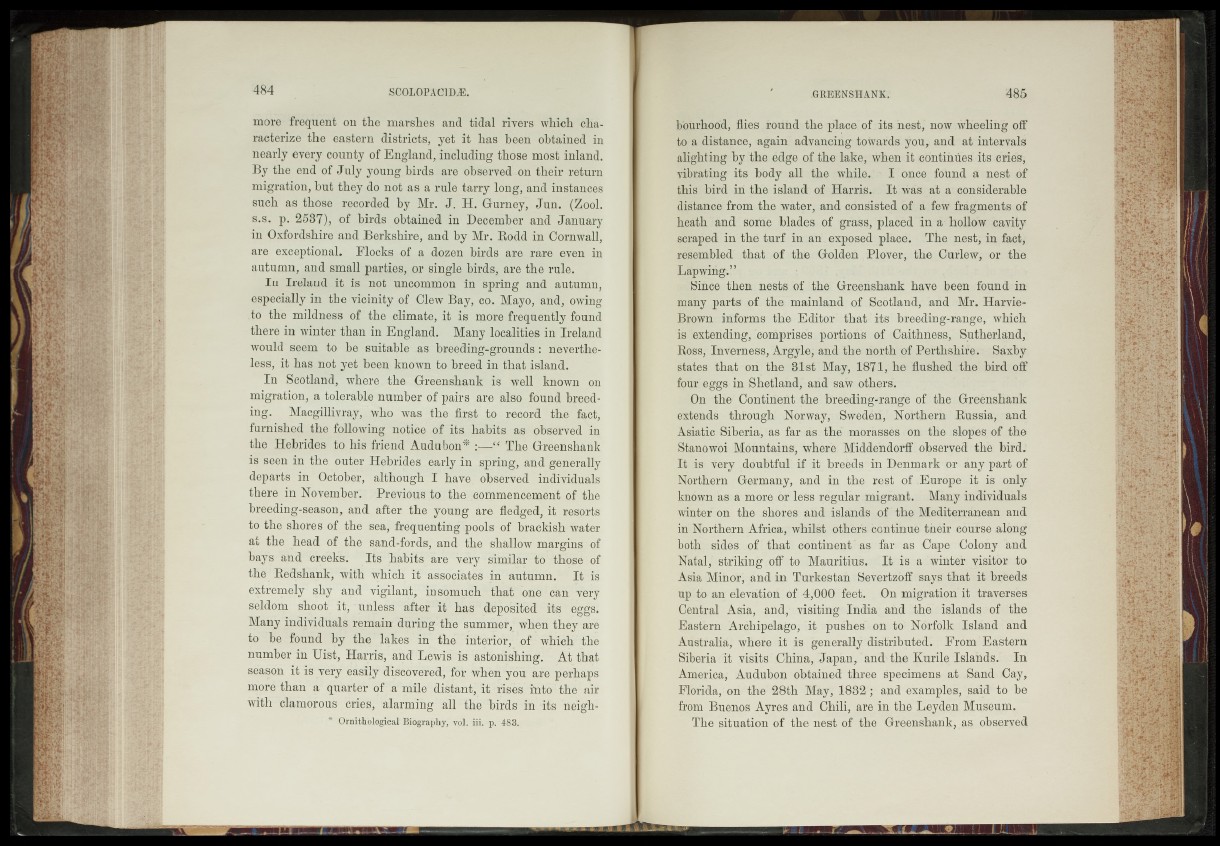
more frequent on the marshes and tidal rivers which characterize
the eastern districts, yet it has been obtained in
nearly every county of England, including those most inland.
By the end of July young.hirds are observed-on their return
migration, but they do not as a rule tarry long, and instances
such as those recorded by Mr. J. H. Gurney", Juni C&ooi.
s.s. p. 2587), of birds obtained in December and January
in Oxfordshire and Berkshire, and by Mr. Rodd in' Cornwall,
are exceptional. Flocks -of a-dozen birds are rare even in
autumn, and srnall parties, or single birds^ are the rule.
In Ireland it is not uncommon in spring and autumn,
especially in the vicinity of Clew Bay, co* Mayo, and>* owing
.to the mildness. ;of the climate, it is mime*frequently found
there in winter than in England. Many localities in Ireland
would'seem to be suitable--as breeding-grounds,: nevertheless’,
it has nel -yet been known to:hjjee<bin that island:
In Scotland, whfere -the Greenshank is well known qn
migration, a tolerable number of pairs -are also found bleeding.
Macgillivray, who was the firgt’jo record thV fact,
furnished the following habits as observed in
the Hebrides^® his friend Audubon^*:—“ The' Graeflshank
is seen in the' outer Hebrides early .in’ spring, and generally
departs in October, although I haye' observed individuals
there in November: ? ‘previous to the. .commencement of the
breeding-season, and after the young are fledged^ft resp-rts
to the shores of the sea-,-frequentinglpools'of brackish'water
at the head of the sand-fords, and the shallow margins^ 'of
hays-and hieSks: Its habits-ain^Sy similar of
the Redshank, with whïêff b^assömales in* autumn.r> - It as
extremely shy and'* vr^i^^ÖinsónQjUph' thatAohé’“ can 'Very
^Ü^m jShnot it, 'Unless after it Jhas ■ deposited'Hts'hggs.
Man.y individuals remain durrUg^tbe ' summêr / vMin they "are
tu be found h y the jakes in the’-intèndr^of' which’the
number in %f§t, Harris, and LewïsRus a'sibmshh^^, At that
season it is very dasily discovered1, for whèhyóü aihfiéihaps
more than a quarter mile distant“!! i r i s e s thé’ air
with Ulamorous 'elié’sj alarming/ail the 'hirdS"4 in jjjjls hfeigh-
,* Ornithological B i o g r a p h y , 483,,-'
bourhood, flies round the placelof its hesti now wheeling off
to a. distance, again: advancing towards ÿou,> and at intervals
alighting hy the edge of.the; lake, when it continues its criés;
vibrating its body all the while.: - I cmee found a nest of
this bird in the island; of Harris. It was at a considerable
distance from the .water, and consisted.5f a; few fragments of
heath/and some blades of grass, placed in a hollow cavity
scraped in thé turf m an .exposed placé. .'.The mest; in fact,
resembled that of the Golden .plover, the, Curlew, or the
Lapwing.”
■*/,Since then nests of the' Greenshank have been found in
many parts of, the mainland of;/Scotland, and .Mr. Harvie-
Broyn informs the Editor' that its breeding-range, which
is .extending, comprises portions of Caithness,. Sutherland,
Ross,Inverness, ArgyLe, and the.northrpf Perthshire. • Saxby
statea thqt- on the- 81st May, 1,871, he flushed .the bird off
four eggs an Shetland,* and saw others. -
j jp u the- Continent the breeding-range of the Greënshank
extends through’ Norway:(rSwedén/ Northern Russia, and
Asiatic; Siberia, fas far as the* morasses mm the slopes;.»! the
StanQwbi, Mountains, where Middendorff; observed-the bird:
It ë&s&Kf doubtful': ifcufr breèdsrin Denmark pr any part of
Northern Germany, and in thg, rest of .Eurftpo.it -is only
known as a more br'less regular migrant.. Many individuals
winter on the .shores; rahd islands of‘the Mediterranean and
in “Northern Africa, whilst others c|htihuë>M& course along
both «sides .»of that! continent’ as; far, as 'Caipg' Colony and
Natal,' stxlMngfftffAto 'Mauritius.' R is a winter,jjsitoiy.to
Asia Mihp>;-i|ând: in Turkestan ’ Sev.ertzbff mays Aart it breeds
ppitb arç éiëvatîpm of 4,:000 ' feet. On migration'it traverses
Central Asia, and,,- - visiting&India and ihèl- islands o f the
^æstèrn 'A-iéhipelago, it pushes tb’ Nbrfôlk /Island >' and
Australia, where it is generally ‘distributed: Erom Eastern
Siberia - it visits! China, 'Japan, Eand- thefRurih Islands/ : In
America, Audubon obtained three specimens- at Sand Cay/
Florida, on the 28th May, 1882-; and example's,1 said4 tb^be
from Buçnps Avres/and ''CMttf are ip tli£ Rml^n Muscurn./
The situation of gemest of the Greenshank, as observed